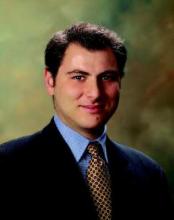Despite significant technologic, diagnostic, and therapeutic advancements, obstructive sleep apnea syndrome (OSAS) remains difficult to treat. The surgical “gold standard” for the treatment of severe OSAS remains tracheotomy. While completely bypassing all sites of upper airway obstruction, this treatment entails a significant alteration in lifestyle, may not be palatable to patients, and has cultural implications. The noninvasive “gold standard” has been positive airway pressure (PAP). When properly titrated and fitted, PAP is curative of OSAS provided the patient is compliant with therapy. Unfortunately, studies demonstrate noncompliance rates in the 40% to 54% range, which significantly drop to 84% at 1 year of use (Terri et al. Proc Am Thoracic Soc. 2008;5[2]: 173).
Alternate treatments have been proposed. These include mandibular advancement devices (MAD) and upper airway surgery. Surgery has been proposed as both adjunctive treatment to PAP and as a potential curative alternative, which does not require “maintenance” on the part of the patient but requires long-term follow-up and observation, especially in the event of symptom recurrence or major fluctuations in body mass index (BMI).
Surgery has fallen in and out of favor in the last 3 decades due to mixed observational and experimental data, particularly the difficulty in constructing good clinical surgical series, as well as the morbidity often associated with these procedures. The challenge of surgical treatment is patient selection, as well as proper surgical procedure selection for each patient. OSAS is a complex disease process composed of both fixed and fluctuating variables. In brief, it is a complex interplay of static factors such as craniofacial anatomy, cephalometrics and nasal anatomy with soft tissue fluctuations dependent on weight, age (tonsil and adenoid size, palatal length), syndromes (macroglossia, palatal function), and varying distribution of fat in the three tongue fat pads and visceral vs peripheral body fat distribution. Couple this with conditions that affect muscle tone, cardio-pulmonary function, “tracheal tug,” and even normal nightly variations in tone with the onset of REM and physiologic transitions that occur from one sleep stage to another, one begins to understand that the patient with OSAS requires an individualized multidisciplinary approach.
Proper understanding of the patient’s physiology and anatomy are crucial to success with treatment.
Physical Examination
The physical examination starts with inspection of the face: does the patient appear syndromic, have significant hemifacial microsomia, major maxillary or mandibular hypoplasia (or both)? These factors can lead to significant difficulty in fitting a PAP mask or MAD. Options for correction include maxillary-mandibular advancement (MMA) or isolated mandibular advancement / reconstruction. MMA is an oromaxillofacial procedure that shifts the entire maxilla and mandible forward; the soft palate, base of the tongue, and, to an extent, the larynx move forward, resulting in multilevel correction. It has the added benefit of potentially improving a patient’s occlusion and cosmetic appearance, as the chin and cheek bones advance to a more favorable position. While this is a major procedure for the patient, success rates have been reported upwards of 90% (Lei et al. Sleep Breath. 2000;4:137).
The nasal exam is crucial. While we start off as obligate nose breathers in infancy, this preference never goes away. Studies demonstrate that PAP requirements between nasal and oronasal masks are equivalent, but patient preference weighs heavily toward nasal masks where leak is significantly reduced (Bakker et al. Sleep Breath. 2012;16[3]:709.
The exam should start with the external nose looking for dorsal deviations (congenital or traumatic), a significant ptotic tip, or lateral nasal wall collapse. Repair of the nasal valve or even functional rhinoplasty are the procedures of choice for these problems.
The internal nasal exam consists of evaluation for turbinate hypertrophy, significant nasal septal deviation, widening of the middle turbinates from concha bullosa, the presence of mucosal edema from allergy or infection, extensive crusting from nasal dryness or septal perforation, significant nasal polyposis or even a nasal tumor. Initiation of PAP therapy is very often a “1 shot deal” and patients who were otherwise motivated to use PAP failed because their nasal obstruction was not diagnosed. Ideally, the exam should include nasal endoscopy.
Intranasal surgical techniques include septoplasty, turbinate reduction, polypectomy, and functional endoscopic sinus surgery. While AHI is usually not significantly affected by nasal surgery, there are major improvements in quality of life scores and PAP compliance (Poirier J, et al. Laryngoscope. 2014;124[1]:317). Rare patients, especially those with complete obstruction, can be cured in mild to moderate cases. In most, it is an important adjunct to the treatment of the patient with OSAS.
The exam should then proceed to the oral cavity and oropharynx. Careful note should be taken of the dentition and occlusion class, arching of the hard palate (especially in children), tongue size (Friedman or Mallampati class), length of soft palate, and uvula and tonsil size. In children and young adults, adenotonsillectomy or tonsillectomy alone can be curative as a first line therapy. Compliance issues with PAP are especially problematic in these populations. High arched palates in children can be managed with rapid maxillary expansion which can significantly broaden both the nasal and oral airway. MMA for retro/micrognathia was discussed previously.


